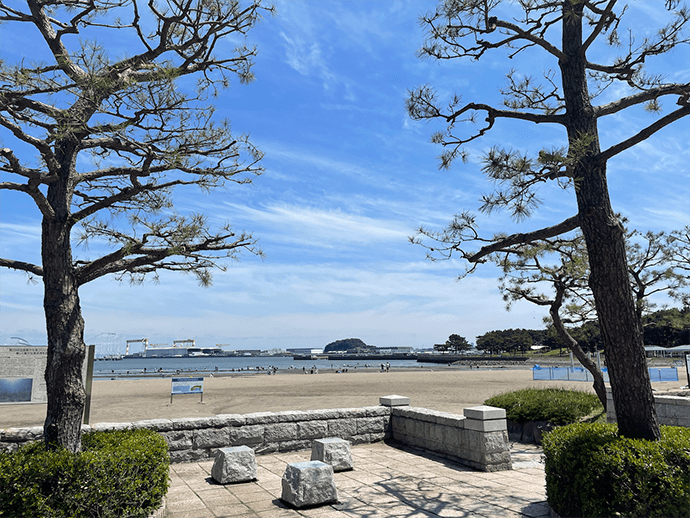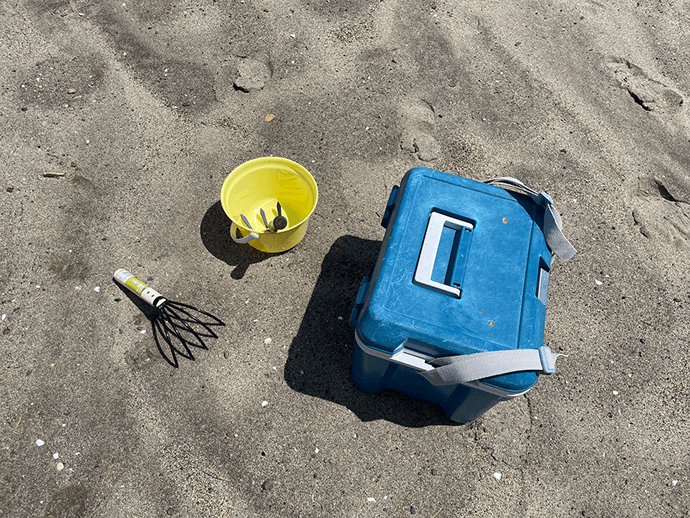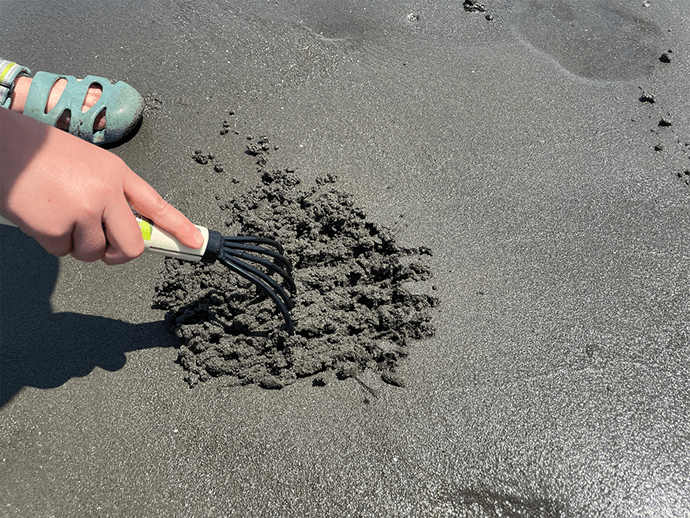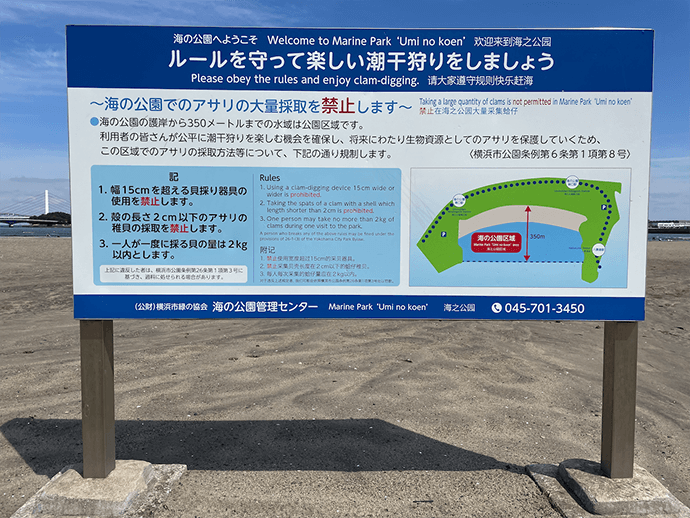
Hot sun, blue skies, cool breeze: When we reached Marine Park, Yokohama, it was a perfect day for clam-digging. Bucket, cooler, and garden forks in hand, we made our way to the shore . . .
-
01
From Ancient Industry to Modern Leisure
Digging for clams has a long history in Japan, going all the way back to the Jomon hunter-gatherers thousands of years ago who left evidence of their diet in the form of shell middens. Even so, it wasn’t until the Edo period (1603–1868), that clam-digging became the leisure activity it is today, building on an earlier tradition of frolicking on tidal flats on the third day of the third lunar month. Before long, shiohigari (literally “low-tide gathering”) was a common theme for ukiyo-e and haiku, and soon it had found its place among Japan’s calendar of seasonal observances.
![Women and children dig for clams in this late-twentieth-century print from a series about Edo customs throughout the year
Toyohara Chikanobu, Public domain, via Wikimedia Commons]()
Women and children dig for clams in this late-twentieth-century print from a series about Edo customs throughout the year Toyohara Chikanobu, Public domain, via Wikimedia Commons
-
02
Planning Your Shiohigari Outing: Location, Date, and Time
It’s best to choose a location that explicitly welcomes clam-diggers, to avoid running afoul of any local rules or regulations. Check out the list of sites at the end of this article for a few ideas!
Next, pick a date and time. You want to be on the beach just as the tide is at its lowest, and you also want that low tide to be as low as possible. This usually means a spring tide, around the full or new moon. Shiohigari locations often post helpful tide schedules on their websites.![Out on the sandbars]()
Out on the sandbars
-
03
Tools of the Trade
Once you know when and where you’ll be clamming, it’s time to get your gear ready! The traditional equipment for shiohigari is:
- A smallgardening fork for clawing through the sand (curved tines are ideal, but straight ones work too)
- Abucket ornet for collecting clams in
- Anice-filled cooler for taking clams home alive
All-in-one shiohigari sets can be found at home centers and even 100-yen stores, although they usually don’t include the cooler.![The bare minimum shiohigari set!]()
The bare minimum shiohigari set!
Don’t forget beach sandals, a hat, sunscreen, fluids, and whatever else you need to protect yourself from clamshells underfoot, sunburn, and heatstroke!
-
04
Shiohigari Technique: Take Them Alive
So, you’re on the tidal flats with your equipment. What next?
The basic idea is to dig in sandy areas revealed by the low tide for clams buried beneath the surface. Find a small area that no one else is using yet, ideally on the shoreward side of a sandbar where clams are likely to have become trapped by the receding tide, and patiently dig into the sand with long, shallow rake strokes.
The Japanese littleneck clam (asari), your main target, is usually buried 5 or 10 centimeters beneath the surface. They tend to stick together, so if you find one, check the surrounding area carefully for others. On the other hand, if you’ve dug a decent 10-centimeter hole and found nothing, try a different spot. Tiny holes in the sand can be a hint to living creatures below.![Rake technique, demonstrated]()
Rake technique, demonstrated
Be careful only to take healthy, living clams, as dead or injured ones can be poisonous. Some locations may also be home to razor clams (mategai) and common hard clams (hamaguri)—look for more information about specific beaches, and make sure you can identify anything you take as an edible species. Once you have enough for dinner in your bucket or net, transfer them to your ice-filled cooler and head home!
You’ll also want to be aware of the rules for clam-digging in the location you visit. For example, at Marine Park in Yokohama, which we visited for this story, you can only take clams 2 cm or more in diameter, and you can’t take home more than 2 kilograms per person. Some places charge an entrance fee. The rules for each location will generally be available online and posted prominently on-site.![The rules at Yokohama Marine Park]()
The rules at Yokohama Marine Park
-
05
Clam Kitchen Confidential
Confession time: While on location researching this story, we didn’t have much luck finding clams, apart from a few that didn’t even clear the 2 centimeter requirement. Asking around the tidal flats, we discovered that no one at Marine Park that day was doing much better. “It’s always clammed out after Golden Week,” explained one local. No problem, though—it was still a fun morning at the beach, complete with starfish sightings. I decided to cheat and pick up some clams at the supermarket on the way home . . .
Once you have, ahem, obtained some clams, preparing them for the dinner table is easy. First, rinse the sand off the clams and transfer them to a bowl or tray. Cover them in water, adding a little salt. (Some people like to take home actual seawater for this purpose.) Leave this somewhere dark for a few hours so the clams can release all their sand.![Desanding clams in salty water]()
Desanding clams in salty water
Next, get cooking! Simply steaming the clams in sake or wine is a popular and easy approach. Once the shells open up of their own accord, the clams are ready enjoy.
![Just add sake]()
Just add sake
-
06
Shiohigari Spots In and Around Tokyo
Yokohama Marine Park (Kanagawa):
We had no luck on our visit, but it’s not a popular shiohigari spot for nothing! Access via the Kanazawa Seaside Line.- Marine Park
-
-
- Kanagawa Pref. Yokohamashi Kanazawa-ku Uminokouen 10
-
-
-
- 0457013450
-
-
-
- Open 24 hours
-
View AllFunabashi Sambanze Seaside Park (Chiba):
This clamming field also has tennis courts, barbecues, and magnificent views of Mount Fuji across Tokyo Bay. Access via Keisei- Funabashi Sanbanze Beach Park
-
-
- Chiba Pref. Funabashishi Shiomichou 40
-
-
-
- 0474350828
-
-
-
- 9:00-17:00 (each Depends on …
-
View AllKasai Marine Park (Tokyo):
Not one but two artificial beaches, one for clam-digging and one serving as a bird sanctuary. Access via the the JR Keiyo Line.- Kasai Seaside Park (Nishi Nagisa)
-
4.0
42 Reviews -
-
- Tokyo Edogawa-ku Rinkaicho 6 Chisaki
-
-
-
- 0356964741
-
View AllOdaiba Marine Park (Tokyo):
Visit the replica Statue of Liberty and ride the Ferris Wheel while in the area. Access via the Yurikamome Line.Egawa Beach Clamming Ground (Chiba):
The only remaining natural tidal flat in Tokyo Bay. Access via bus from Iwane Station on the Uchibo Line.







 Go here
Go here









